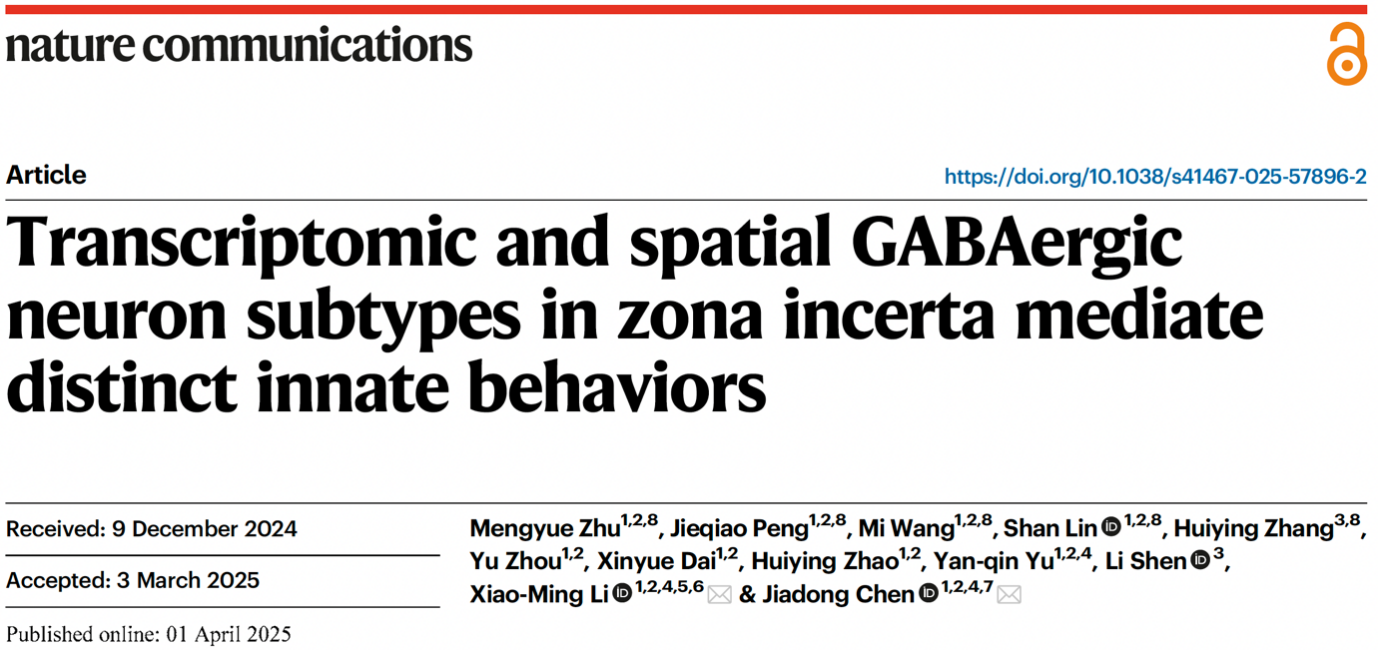The molecular, morphological and anatomical features of neurons imply distinct neuronal subtypes, axonal projection pattern, and behavioral functions in the central nervous system. Since Ramon y Cajal first illustrated nerve cell morphology using Golgi staining and established the "Neuron Doctrine" over a century ago, the diverse morphological characteristics and functions of neuron subtypes have become increasingly evident. Recent advances in single-cell transcriptomics have further enabled the identification of gene expression profiles and molecular markers unique to specific transcriptomic cell subtypes. However, the behavioral functions of these transcriptomic subtypes in living animals remain largely unexplored. Therefore, investigating the anatomical connectivity and behavioral roles of transcriptomic and spatial neuron subtypes is crucial for understanding the brain's functional organization.
The zona incerta (ZI), located in the ventral thalamus, consists of morphological and genetically diverse neuron subtypes. Recent studies have revealed that ZI neurons project broadly to various brain regions, contributing to the regulation of behaviours including feeding, predation, sleep, pain and novelty seeking. However, the specific neuronal substrates mediating these behaviors are still unclear.
Dr. Jiadong Chen's group previously identified long-range GABAergic projection neurons in that ZI that project to the cortex and regulate the development of apical dendrites in cortical pyramidal neurons (Chen et al., Science 2015). They also demonstrated that somatostatin-positive neurons in the ZI modulate innate fear responses via GABAergic projections to the nucleus reuniens (Lin et al., Neuroscience Bulletin 2023).

On April 1st, 2025, Dr. Jiadong Chen and Professor Xiaoming Li's research team published a research article titled "Transcriptomic and spatial GABAergic neuron subtypes in zona incerta mediate distinct innate behaviors" in Nature Communications.
In this study, they used single nucleus RNA sequencing and fluorescent in situ hybridization to identify specific markers genes expressed in the rostral and medial regions of zona incerta. They then constructed transgenic mice that selectively labeled GABAergic neurons in the rostral ZI (using Ecel1-Cre) and medial ZI (using Pde11a-Cre). Through a combination of in vivo circuit tracing, optogenetic and chemogenetic approaches, they discovered that Ecel1-expressing neurons in the rostral ZI project to the periaqueductal gray (PAG) and mediated self-grooming behavior, while Pde11a-expressing neurons in the medial ZI project to the pontine reticular nucleus (PnO) and promote wakefulness. These findings reveal key molecular markers and behavioral roles of previously unidentified GABAergic neuron subtypes in the ZI - making a significant step toward understanding the functional organization of the brain.

This study was jointly conducted by Ph.D. students Mengyue Zhu, Jieqiao Peng, Mi Wang, Shan Lin and Huiying Zhang, in collaboration with Professor Xiaoming Li’s laboratory at Zhejiang University. The study also received valuable support from the teams of Professors Shumin Duan, Yanqing Yu and Li Shen at Zhejiang University.
Dr.Jiadong Chen's lab at Zhejiang University School of Medicine is dedicated to functional genomics research in neuroscience by integrating single-cell genomics, calcium imaging, and electrophysiology. Their recent research findings have been published in top international journals including the Journal of Clinical Investigation (2025), Nature Communications (2025), Advanced Science (2024), and Neuroscience Bulletin (2022, 2023). The lab is currently recruiting graduate students and postdoctoral researchers interested in neurobiology, cell biology, and genomics, offering competitive benefits. Interested candidates are encouraged to send their CV and research interests to jardongchen@zju.edu.cn.

Paper link: https://www.nature.com/articles/s41467-025-57896-2





 Location :
Location : 

